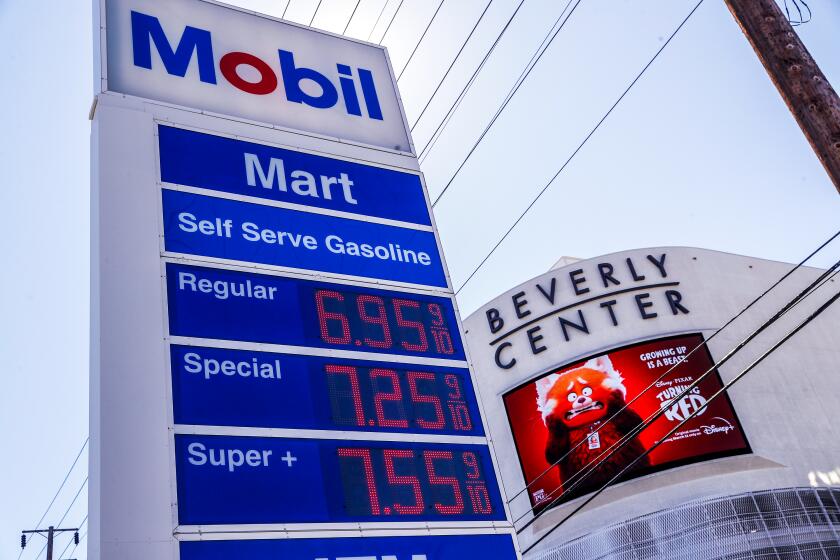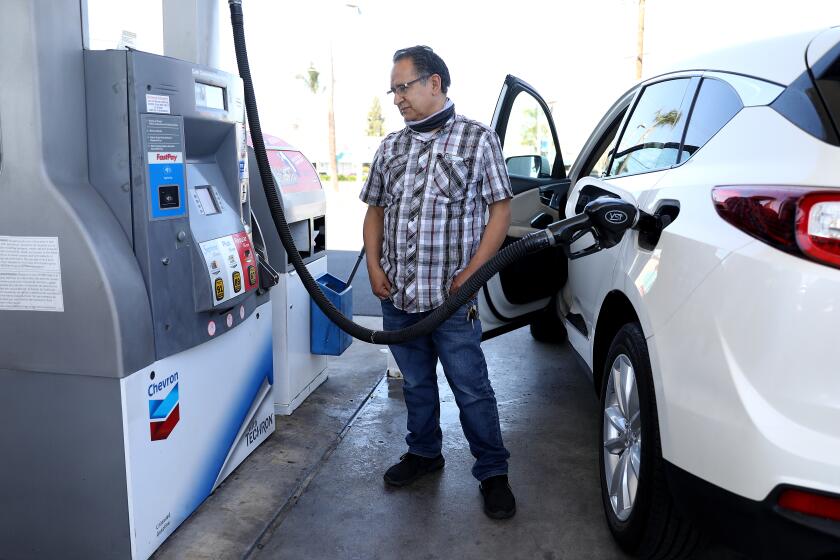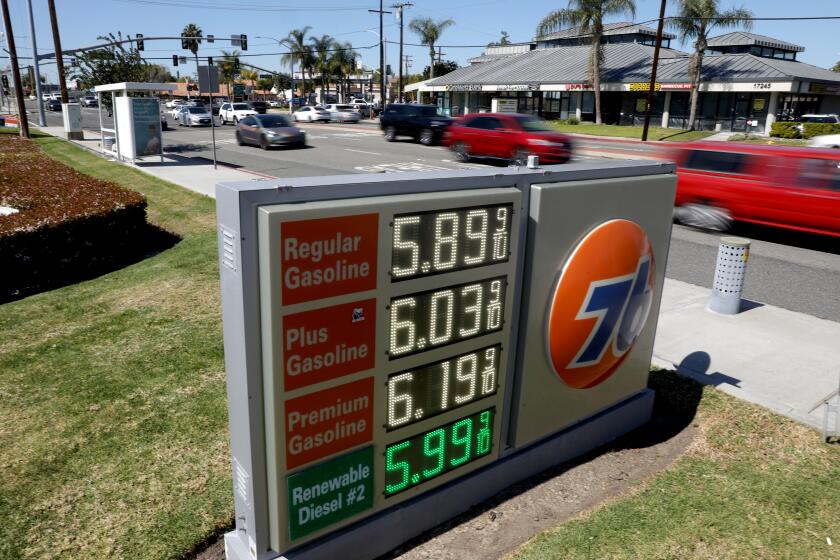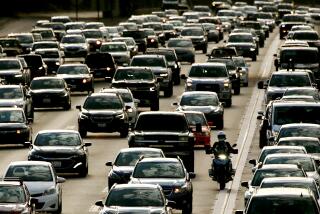Gas prices are falling nationwide. Will California drivers see some relief?
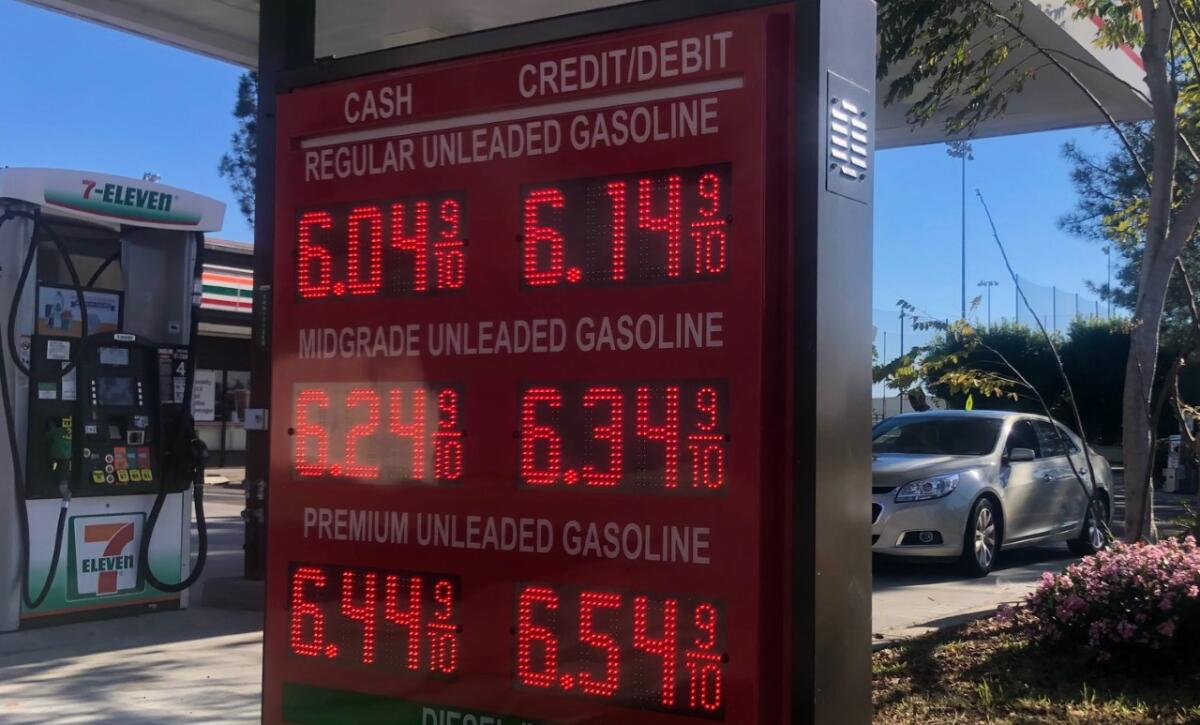
- Share via
The average national price of regular gas has slipped under $5, marking the first time the closely watched number has decreased in nine weeks, according to AAA.
That’s little consolation for California drivers who paid an average of $6.38 a gallon as of Tuesday, but it’s an indication that prices could be slightly lower before the July 4 holiday, experts say.
Consumer gas prices dipped slightly in California in recent days, with the state average falling nearly 6 cents over the last week, AAA’s survey of gas station prices showed.
Los Angeles County saw its largest daily decrease in the average price for a gallon of regular gasoline since April 13, with prices dropping 1.5 cents to $6.403 on Tuesday.
As in L.A., the Orange County average also has decreased for seven consecutive days, dropping 1.4 cents overnight to $6.334.
You’ve seen the signs advertising $6.95, $6.99 or even $7.05 for a gallon of regular unleaded. But who’s buying it, and why?
Pump prices are declining in part because of a reduction in demand for fuel, reported by the U.S. Energy Information Administration, as more drivers change daily routines and prioritize budgets for recreational travel, said Doug Shupe, corporate communications manager for the Automobile Club of Southern California.
Even more important, the wholesale price of oil fell by about 40 cents nationally and by 60 cents in California in the last week, said Marie Montgomery, spokesperson for the Automobile Club of Southern California.
Montgomery said the drop was due partly to the Federal Reserve’s move last week to raise interest rates.
“There’s sort of a negative reaction with commodities when interest rates are going to be raised,” Montgomery said. “So that was really the trigger for why we are seeing gas prices now coming down.”
At some California gas stations, prices have dipped below $6 a gallon, Montgomery said. They could fall further if high fuel costs continue creating “demand destruction,” as consumers opt to travel less rather than face high prices at the pump.
But don’t expect prices to plummet rapidly, nationwide or in California.
Gas prices are high across California, and it’s unclear when prices will go down. But, there are ways to save money on gas. Here are some tips.
Shupe said that despite the slight reduction in gasoline demand nationwide, the need to consume gasoline remains high as we head deeper into the summer travel season.
“It’s unlikely we’re going to see any extreme drops anytime soon,” Shupe said. “The reason is, we still have the two biggest pressures that are putting the upward pressure on prices at the pump” — supply and demand.
The supply side pressure comes primarily from global oil concerns because of Russia’s war on Ukraine. The demand pressure comes from all that driving everyone still must do, both for work and travel.
“We are in that period of the year when we have many people taking recreational leisure trips by automobile,” Shupe said.
Demand may increase — and so too may prices — as the July 4 holiday approaches, similar to the increase seen during the Memorial Day weekend.
“We did see a projected increase that did materialize for Memorial Day travel,” Montgomery said. “Locally, our travel agents are very busy booking trips. People are really eager to get out there as more of the restrictions are falling.”
Oil has fluctuated while pump prices stayed high. Analysts expect the cost of gas to stay up for now, but lawmakers are discussing relief options.
One reason for California’s higher fuel prices is the state’s environmental laws, which require refiners to follow specific gasoline formulas designed to reduce air pollution when the temperature is high.
With few suppliers producing the state’s unique gasoline blend, California’s market has less competition and little ability to import fuel from other markets.
Then come the taxes. A tax charged to gasoline suppliers before delivering to retail stations is passed along to California drivers in the form of higher prices at the pump, according to the Legislative Analyst’s Office.
California drivers also have to pay a federal excise tax on gasoline, similarly charged to suppliers and passed to consumers, which amounts to 18.4 cents per gallon, according to the U.S. Energy Information Administration.
Beyond taxes, the American Petroleum Institute, a trade association for the U.S. oil industry, estimates that the country’s demand for petroleum has reached highs reminiscent of the 1960s.
The price of crude oil is the most significant component of the gasoline costs, representing 60% of the price per gallon, EIA estimated.
Russia’s invasion of Ukraine has also had a ripple effect on the global market, as Russia is the second-largest contributor of crude and refined oil globally. Since the crisis, the price has surged, reaching highs of $122 a barrel and staying above $90 since Feb. 25.
More to Read
Inside the business of entertainment
The Wide Shot brings you news, analysis and insights on everything from streaming wars to production — and what it all means for the future.
You may occasionally receive promotional content from the Los Angeles Times.
